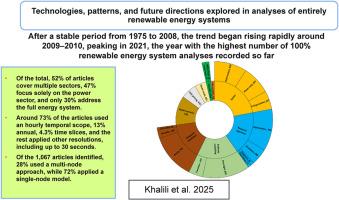100%可再生能源系统分析的技术、趋势和轨迹
IF 16.3
1区 工程技术
Q1 ENERGY & FUELS
引用次数: 0
摘要
能源系统是温室气体排放的主要来源,也是气候变化的主要驱动因素。本研究对1975年至2023年间发表的文章进行了系统回顾,选择了在特定地理环境下至少一个能源部门中可再生能源占95%以上的能源系统。根据这些标准,共有1067篇文章被确定并纳入审查。该综述确定了100%可再生能源系统分析中使用的技术、模型和技术的趋势。电力部门受到的评估最多,99.5%的研究中出现了电力部门,47%的研究进行了专门分析。68%的研究使用了优化目标函数。每小时的时间分辨率是最常见的,在73%的研究中有体现,而77%的研究使用隔夜绿地模型。风能和太阳能光伏成为最普遍的技术,分别在2002年和1001年的研究中对能源系统做出了贡献。电池是使用最多的储能技术,有642项研究,其次是e-氢,有486项研究。热泵是供热领域的领先技术,在32%的基于使用情况的研究中占有重要地位。在交通运输领域,电池电动汽车是最常见的技术,出现在33%的研究中。尽管研究数量不断增加,但全面的跨部门分析仍然有限,需要进一步研究来评估能源系统转型中每个要素的价值贡献。本文章由计算机程序翻译,如有差异,请以英文原文为准。

Technologies, trends, and trajectories across 100% renewable energy system analyses
The energy system is the primary source of greenhouse gas emissions and a major driver of climate change. This study conducts a systematic review of articles published between 1975 and 2023, selecting those that examine energy systems with at least 95% renewable energy in at least one energy sector within a defined geographic context. Based on these criteria, a total of 1067 articles were identified and included in the review. The review identifies trends in technologies, models, and techniques used in 100% renewable energy system analyses. The power sector was the most assessed, appearing in 99.5% of studies and exclusively analysed in 47%. Optimisation target functions were used in 68% of studies. Hourly time resolution was the most common, featured in 73% of the studies, while 77% used overnight greenfield modelling. Wind power and solar photovoltaics emerged as the most prevalent technologies, contributing to the energy system in 1002 and 1001 studies, respectively. Batteries were the most used storage technology with 642 studies, followed by e-hydrogen in 486 studies. Heat pumps were the leading technology in the heat sector, featured in 32% of studies based on usage. In the transport sector, battery electric vehicles were the most common technology, appearing in 33% of studies. Despite the growing volume of research, comprehensive cross-sectoral analyses remain limited, and further research is needed to assess the value contribution of each element in energy system transitions.
求助全文
通过发布文献求助,成功后即可免费获取论文全文。
去求助
来源期刊

Renewable and Sustainable Energy Reviews
工程技术-能源与燃料
CiteScore
31.20
自引率
5.70%
发文量
1055
审稿时长
62 days
期刊介绍:
The mission of Renewable and Sustainable Energy Reviews is to disseminate the most compelling and pertinent critical insights in renewable and sustainable energy, fostering collaboration among the research community, private sector, and policy and decision makers. The journal aims to exchange challenges, solutions, innovative concepts, and technologies, contributing to sustainable development, the transition to a low-carbon future, and the attainment of emissions targets outlined by the United Nations Framework Convention on Climate Change.
Renewable and Sustainable Energy Reviews publishes a diverse range of content, including review papers, original research, case studies, and analyses of new technologies, all featuring a substantial review component such as critique, comparison, or analysis. Introducing a distinctive paper type, Expert Insights, the journal presents commissioned mini-reviews authored by field leaders, addressing topics of significant interest. Case studies undergo consideration only if they showcase the work's applicability to other regions or contribute valuable insights to the broader field of renewable and sustainable energy. Notably, a bibliographic or literature review lacking critical analysis is deemed unsuitable for publication.
 求助内容:
求助内容: 应助结果提醒方式:
应助结果提醒方式:


